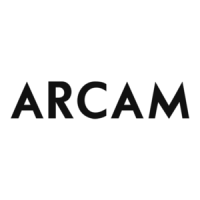English
DV79
E-9
The HDMI interface
If you have a HDMI- or DVI-equipped monitor or display, you can connect it to the DV79 using a HDMI
cable. The HDMI connector carries uncompressed digital video, as well as digital audio.
About HDMI
HDMI (High Denition Multimedia Interface) supports both video and audio on a single digital connection
for use with DVD players, digital TV, set-top boxes, and other AV devices. HDMI was developed to
combine the technologies of High-bandwidth Digital Content Protection (HDCP) and the Digital Visual
Interface (DVI) in one specication, with the addition of transmission of digital audio information; HDCP
is used to protect digital content transmitted to DVI-compliant displays.
HDMI has the capability to support standard (interlaced), enhanced, or high-denition video together
with stereo or multi-channel surround-sound audio. HDMI features include uncompressed digital video,
one connector (instead of several cables and connectors), and communication between the AV source
and AV devices.
Connecting using HDMI
If the HDMI connector is to be used, we recommend rst setting the ‘Output Priority’ item on the video
menu page to ‘HDMI/DVI’. This will give full ‘plug and play’ functionality. See page 14 for details on how
to do this.
Use a HDMI cable to connect the HDMI socket on this player to a HDMI socket on a compatible display
device or receiver. The arrow on the cable connector body should be face up for correct alignment with
the connector on the DV79. If the DV79 has been congured to ‘HDMI priority’, then the DV79 will
congure its video output automatically to match the capabilities of the attached HDMI device. If the
connection was successful, ‘HDMI’ or ‘DVI’ is shown briey via the on-screen display according to the
compatibility of the connected component.
NOTE: A HDMI connection can be made only with HDMI or DVI-equipped components compatible
with both DVI and HDCP. Note that if you choose to connect to a DVI device, you will need an adaptor
(HDMI to DVI) to do so; a DVI/HDCP connection, however, does not support audio signals.
If you require further information on the possibilities for connecting your DV79 to your DVI/HDMI
equipped display device, please contact your Arcam dealer.
Troubleshooting
Problems with video
NO VIDEO (BLANK SCREEN)
n
Check that the HDMI cable is connected correctly at both ends. If an HDMI-equipped A/V
receiver is in use, try connecting the DV79 directly to the display device, in order to isolate
where the fault may lie.
n
Check that the display device is set to display the HDMI input (i.e., has not been set to some
other video input, instead).
n
Check that the HDMI connector of the receiver and/or display device is enabled. See the user
handbook of the connected device for details on doing this.
n
Using an alternative video display device (e.g., connected via the composite video out), check
that the ‘Output Priority’ item on the Video page of the Set-up menu is set to ‘HDMI / DVI’. See
page 14 for details on how to do this.
n
Consult the user handbook of the display device to ensure that it can handle the output formats
provided by the DV79. The DV79 can provide the following: 720x480P (NTSC progressive scan),
720(1440)x480i (NTSC interlaced), 720x576P (PAL progressive scan) and 720(1440)x576i (PAL
interlaced). At least one of these must be supported by the connected device in order for it to
work with the DV79.
NO VIDEO (RANDOM NOISE)
Random noise will be displayed if the content-protection algorithm fails to authenticate the attached
device. This will occur, for example, if a DVI device that does not support HDCP (such as a computer
monitor) is connected to the DV79.
To attempt to isolate this problem, remove all discs from the DV79, the power-off both it and the
connected display device. Switch the display device on, then the DV79 – at this point, the idle logo of the
DV79 should be shown on the display device. If this is not the case, please check the items listed above
for a blank screen.
If the noise appears when a copy-protected disc (DVD) is played, then it is the authentication that is
failing. Please contact your dealer for further information.
Problems with audio
The audio provided by the HDMI connector is the same as that provided through the SPDIF socket. Note
that pure DVI devices (connections requiring a HDMI to DVI convertor cable) do not support audio via
this connection.
If you have a HDMI device, try setting the audio output to Audio item of the Set-up menu to ‘PCM/2 Ch.’;
it may be that the display device supports only 2-channel audio.

